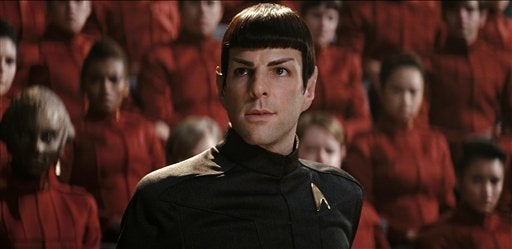
I can't remember wanting to love a movie as much as I wanted to love the new Star Trek.
I grew up watching the original series in re-runs, entranced by the hard-charging, womanizing captain of the Enterprise, his coolly logical (but underneath the exterior, tormented and passionate!) first officer, and its egalitarian vision of the future.
I watched every episode. I went to all the movies. I devoured every paperback that detailed the further adventures of the Enterprise's crew. When I was thirteen, I even -- oh, this is painful -- convinced my parents to take me to a Star Trek convention in downtown Hartford. (My parents were not the most socially adroit people, but even they somehow realized that this was a severely nerdy undertaking. They dropped me off at the corner).
When the ads for the new film started running, I should have been suspicious. "Not your father's Star Trek?" What was wrong with my father's Star Trek? I liked my father's Star Trek! But still, there I was, on opening day, with a bucket of popcorn, surrounded by what looked like the entire staff of several area comic-book stores.
There was much to love about the movie. Kirk was hot, and Spock was cool, and their relationship felt just right, at once edgy and familiar. Unlike the earlier outings, where a shaken camera connoted a collision, danger, and/or black holes and time warps, the special effects were, indeed, special.
I'm not so much of a nerd that I couldn't handle the way the film chucked continuity and ignored some of the original show's rules of the road (although, note to J.J. Abrams: if a Vulcan is bonded and his spouse suddenly dies, he either dies, too, or ends up in mortal agony, and should not be depicted just calmly hanging out on a transporter pad. Okay, fine, maybe I am that much of a nerd).
I was even okay with the way the plot recycled Star Trek II: The Wrath of Khan (in "Khan," the villain deploys a Doomsday weapon because he believes Kirk was responsible for the death of his wife. In "Trek," the villain deploys a Doomsday weapon because he believes Spock was responsible for the death of his wife....and let me just add that, in the all-important categories of "pecs," and "scenery chewing," Eric Bana is no Ricardo Montalban.)
Honestly, I didn't have a problem until about midway through the film...at which point I realized that every single lady on screen was either a mother, a ho, or an intergalactic hood ornament.
We begin with mama Kirk. As the film opens, she screams and grunts her way through labor, pops out young James T., bids her doomed husband a weepy farewell, and is never seen or heard from again. How does she feel when her reckless son runs off to join Starfleet? We don't know. The movie doesn't ask.
Next up: the luscious Andorian Kirk beds at Starfleet Academy. She's green. That's about it...except somewhere, Eddie Murphy is smiling (I'd link to his bit about the dubious hygiene of green-faced girls, but it's filthy. Filthy!)
Even though Romulan war ships were, in the original series, frequently commanded by women, there's nary a chick aboard rogue Romulan Nero's vessel. This, perhaps, explains why he and his crew are in such a bad mood.
The film throws the ladies a few bones in the form of a couple of female members of the Vulcan High Council. There's a woefully underutilized Winona Ryder as Spock's human mother, and a tossed-off reference to Leonard McCoy's ex (the bitch took everything, don'tcha know, leaving him with just his...well, never mind).
Finally, there's Uhura...and what Abrams and company do with the Enterprise's communications officer will not be warming the cockles of any feminist hearts.
We first meet her at a bar, all ponytail, miniskirt, and long legs. Kirk hits on her. She brushes him off. He persists, prompting Uhura's fellow cadets to mop the floor with him (couldn't she have kicked his ass herself? Probably. So why didn't the movie let her?)
We are told, rather than shown, that Uhura is an extraordinarily capable linguist. We are told, rather than shown, that she's intercepted an important transmission, the plot device that jump-starts the film's action...as soon as Kirk tells Captain Pike about it. But Uhura's primary function isn't professional. Her job, in this brave new universe, is to look cute in a red dress, and to humanize (and by "humanize" I mean "mack on") her coolly logical, eminently reasonable mate.
In other words, she's Michelle Obama in outer space.
I'm willing to be patient here. I understand that, to attract an audience glutted on testosterone-heavy summer flicks, you need a certain amount of the old ultraviolence to get butts in seats, and that the lofty, utopian ideals of the original have to make way for a few brute shoot 'em ups. I understand the value of simply showing audiences an (allegedly) strong black woman, even if most of what she does is stand around looking worried; the same way I know that Michelle Obama has to tread carefully as she makes the role of First Lady her own. And hey, maybe organic gardening and pairing J. Crew twin sets with kicky belts and cute pins aren't bad places to start. Baby steps.
In spite of my disappointment, I've still got high hopes for the new Trek franchise. In a few years, my daughters will be old enough to watch TV and movies the way I watched them: for entertainment, yes, but for inspiration, too, for a vision, or a series of competing and overlapping visions, of how their future could look.
Plus, if the guy who gave us Sydney Bristow and Kate Austin can't serve up any kick-ass, take-charge ladies, then who can? It's only logical.